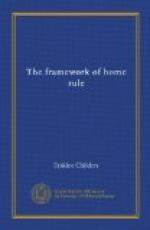English policy was as fatuous as it was cruel. Numbers of the Irish manufacturers and artisans, both Catholic and Protestant, emigrated to Europe, and devoted their skill and energy to strengthening industries which competed with those of England. Within Ireland, since industry and commerce formed the one outlet left by the Penal Code for Catholic brains and capital—though even here the Code imposed harassing disabilities—the commercial restrictions completed the ruin of the proscribed sect. But at this period the main source of weakness to Ireland, of strength to America, and of danger to the Empire as a whole, was the Protestant emigration. Lecky estimates that 12,000 Protestant families in Dublin and 30,000 in the rest of the country were ruined by the suppression of the wool trade. The great majority of these Protestants were Presbyterians belonging to North-East Ulster, and descendants of the men who had defended that Province with such desperate gallantry against the Irish insurgents under the deposed James II. Political power in Ireland was wielded in the interests of a small territorial and Episcopalian aristocracy, largely absentee. The Dissenters belonged to the middle and lower classes, and were for the most part tenants or artisans. Creed and caste antipathies were combined against them. Their value as citizens was ignored. Though their right to worship was legally recognized by an Act of 1719, they remained from 1704 to 1778 subject to the Test, were incapacitated for all public employment, and were forbidden to open schools. Under an accumulation of agrarian, economic, and religious disabilities, they naturally left Ireland to find freedom in America. And it is beyond question that they turned the scale against the British arms in the great War of Independence.




